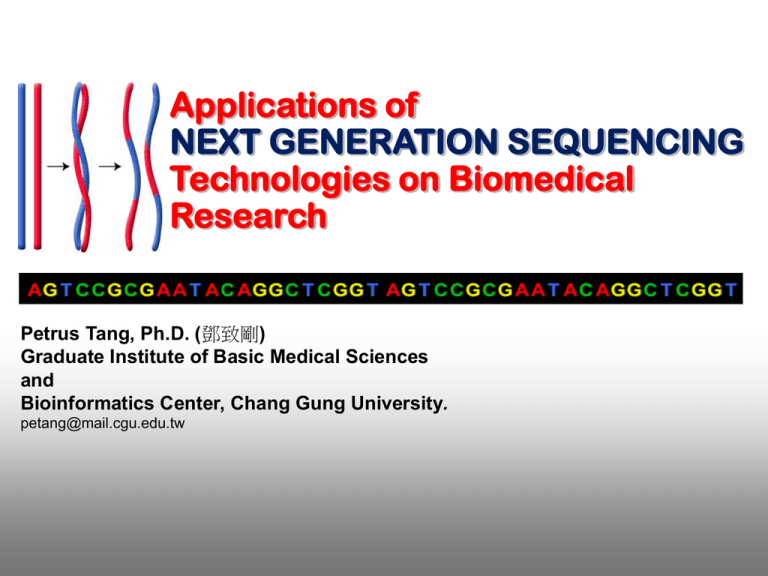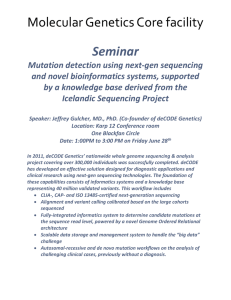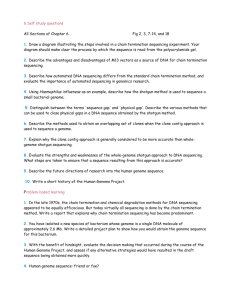sequencing-by
advertisement

Applications of NEXT GENERATION SEQUENCING Technologies on Biomedical Research Petrus Tang, Ph.D. (鄧致剛) Graduate Institute of Basic Medical Sciences and Bioinformatics Center, Chang Gung University. petang@mail.cgu.edu.tw Sanger Dideoxy Sequencing Sanger, F. et al. Nature 24, 687–695 (1977). Sanger, F., Nicklen, S. & Coulson, A.R. Proc. Natl. Acad. Sci. USA 74, 5463–5467 (1977). ABI 3730 XL DNA Sequencer 96/384 DNA sequencing in 2 hrs, approximately 600-1000 readable bps per run. 1-4 MB bps/day A human genome of 3GB need 750 days to finish 1X coverage http://www.ncbi.nlm.nih.gov/sites/entrez?db=genome The Genome database provides views for a variety of genomes, complete chromosomes, sequence maps with contigs, and integrated genetic and physical maps. The database is organized in six major organism groups: Archaea, Bacteria, Eukaryotae, Viruses, Viroids, and Plasmids and includes complete chromosomes, organelles and plasmids as well as draft genome assemblies. http://www.genomesonline.org/ NATURE METHODS | VOL.5 NO.1 | JANUARY 2008 Nature Methods' Method of the Year 2007 goes to nextgeneration sequencing. This series of articles showcase how these novel sequencing methods came into their own in 2007 and the incredible impact they promise to have in a variety of research applications. The Methods to Watch feature provide a glimpse and a wish list for future Methods of the Year. Next Generation Sequencing Technology Massively Parallel Signature Sequencing (MPSS) Roche 454 GS FLX http://www.454.com/ Illumina SOLEXA http://www.illumina.com/pages.ilmn?ID=250 Applied Biosystems SOLID http://marketing.appliedbiosystems.com/ VisiGen Biotechnologies http://visigenbio.com/ Helicos BioSciences http://www.helicosbio.com/ Polonator http://www.polonator.org/ Next Generation Sequencing Technology Roche 454 GS FLX Pyrosequencing Illumina SOLEXA Sequencing by synthesis Applied Biosystems SOLID Sequencing by ligation VisiGen Biotechnologies Single-molecule sequencing Helicos BioSciences Nanopore sequencing Polonator Sequencing by ligation Step 1. DNA Library Preparation Step 2. Emulsion PCR (emPCR) Step 3. Pyrosequencing DNA polymerase add the A.T.C.G ATP sulfurylase convert pyrophosphate to ATP luciferasereact the ATP with luciferin to generate light apyrase degrade unincorporated dNTPs and excess ATP resultread the signal of light 454 technology (Pyrosequencing) Sample preparation. Fragments of DNA are ligated to adapters that facilitate their capture on beads (one fragment per bead). A water-in-oil emulsion containing PCR reagents and one bead per droplet is created to amplify each fragment individually in its droplet. After amplification, the emulsion is broken, DNA is denatured and the beads, containing one amplified DNA fragment each, are distributed into the wells of a fiber-optic slide. Pyrosequencing. The wells are loaded with sequencing enzymes and primer (complementary to the adapter on the fragment ends), then exposed to a flow of one unlabeled nucleotide at a time, allowing synthesis of the complementary strand of DNA to proceed. When a nucleotide is incorporated, pyrophosphate is released and converted to ATP, which fuels the luciferase-driven conversion of luciferin to oxyluciferin and light. As a result, the well lights up. The read length is between 100 and 150 nucleotides. Solexa Genome Analyzer Solexa Genome Analyzer Cluster Generation Clusters Array Template Bridging Denaturation Ready For Sequencing Sequencing-By-Synthesis Incorporation Fluorescent Detection Sequence Generated At Every Site On The Array Sequence Differences Called: Alignment to Reference Genome Solexa technology (sequencing-by-synthesis) Sample preparation. Fragments of DNA are ligated to end adapters, denatured and bound at one end to a solid surface already coated with a dense layer of the adapters. Each single stranded fragment is immobilized at one end, while its free end ‘bends over’ and hybridizes to a complementary adapter on the surface, which initiates the synthesis of the complementary strand in the presence of amplification reagents. Multiple cycles of this solid-phase amplification followed by denaturation create clusters of ~1,000 copies of single-stranded DNA molecules distributed randomly on the surface. Sequencing with reversible terminators. Synthesis reagents, added to the flow cell, consist of primers, DNA polymerase and four differently labeled, reversible terminator nucleotides. After incorporation of a nucleotide, which is identified by its color, the 3′ terminator on the base and the fluorophore are removed, and the cycle is repeated for a read length of 30–35 nucleotides. Step 1. Library preparation Step 2. Emulsion PCR Step 3. Sequencing-by-synthesis SOLiD technology (sequencing-by-ligation) Sample preparation. Fragments of DNA are ligated to adapters and amplified on beads by emulsion PCR. The DNA is denatured and the beads deposited onto a glass slide. Sequencing by ligation. A sequencing primer is hybridized to the adapter and its 5' end is available for ligation to an oligonucleotide hybridizing to the adjacent sequence. A mixture of octamer oligonucleotides compete for ligation to the primer (the bases in fourth and fifth position on these oligos are encoded by one of four color labels). After its color has been recorded, the ligated oligonucleotide is cleaved between position 5 and 6, which removes the label, and the cycle of ligation-cleavage is repeated. In the first round, the process determines possible identities of bases in positions 4, 5, 9, 10, 14, 15, etc. The entire process is repeated, offset by one base by using a shorter sequencing primer, to determine positions 3, 4, 8, 9, 13, 14, etc., until the first base in the sequencing primer (position 0) is reached. Since the identity of this base is known, the color is used to decode its neighboring base at position 1, which in turn decodes the base at position 2, etc., until all sequence pairs are identified. The current read length is between 30 and 35 nucleotides Comparison of existing methods February 2001: Completion of the Draft Human Genome Science, 16 February 2001 Vol. 291, Pages 1145-1434 Nature, 15 February 2001 Vol. 409, Pages 813-960 April 2003: High-Resolution Human Genome Nature, 23 April 2003 Vol. 422, Pages 1-13 >10 years to finish USD 3 billion Next Generation Sequencing Technology Human Reference Genome April, 2003 >10 years to finish USD 3 billion James Watson’s Personal Genome June, 2007 1 year USD 2 million Craig Venter’s Personal Genome September, 2007 1 year USD 1 million Personal Genome 2007 3 months ~ USD 0.5 million USD 10000 Genome in 2015 The 1000 Genomes Project is an international research consortium formed to create the most detailed and medically useful picture to date of human genetic variation. The project involves sequencing the genomes of approximately 1200 people from around the world and receives major support from the Wellcome Trust Sanger Institute in Hinxton, England, the Beijing Genomics Institute Shenzhen in China and the National Human Genome Research Institute (NHGRI), part of the National Institutes of Health (NIH). Drawing on the expertise of multidisciplinary research teams, the 1000 Genomes Project will develop a new map of the human genome that will provide a view of biomedically relevant DNA variations at a resolution unmatched by current resources. As with other major human genome reference projects, data from the 1000 Genomes Project will be made swiftly available to the worldwide scientific community through freely accessible public databases. On 4 September 2008, the co-chairs of the analysis group and overall project co-chairs drafted a letter to the NIH Council about 1000 Genomes Project. This letter, available here, reviews the goals, describes the current status, and provide an update on the critical tasks the Analysis Group must accomplish in order to deliver a valuable community resource and achieve the Project's goals. The Scientific Goals of the 1000 Genomes Project To produce a catalog of variants that are present at 1 percent or greater frequency in the human population across most of the genome, and down to 0.5 percent or lower within genes. Next-next-generation Sequencer Nanopore sequencing Nucleic acids driven through a nanopore. Differences in conductance of pore provide readout. Real-time monitoring of PCR activity Read-out by fluorescence resonance energy transfer between polymerase and nucleotides or Waveguides allow direct observation of polymerase and fluorescently labeled nucleotides Helicos Biosciences: Single molecule sequencing-by-synthesis http://visigenbio.com/mission.html http://www.polonator.org/index.htm VIDEOS http://www.454.com/productssolutions/multimedia-presentations.asp Genome Sequencer FLX Multimedia Presentation Genome Sequencer FLX Standard Series Workflow Presentation Genome Sequencer FLX Amplicon Sequencing Presentation http://www.illumina.com/technology/sequencing_technology.ilmn http://marketing.appliedbiosystems.com/images/Pro duct/Solid_Knowledge/flash/102207/solid.html http://www.helicosbio.com/Technology/TrueSingleMoleculeS equencing/tSMStradeHowItWorks/tabid/162/Default.aspx http://visigenbio.com/technology_movie_streaming.html






